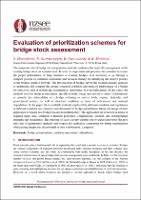Evaluation of prioritization schemes for bridge stock assessment

Download
Date
2023-04-19Authors
Hamidpour, Sara
Scattarreggia, Nicola
Nascimbene, Roberto
Monteiro, Ricardo
Metadata
Show full item recordAbstract
The important role of bridges in transportation network resiliency has made the management of the existing bridge stock an essential task. In order to implement and prioritise the activities to secure the proper performance of large numbers of existing bridges, it is necessary to go through a complex process of condition assessment and decision-making for identifying the relative priority of the bridges within a network. The prioritization of bridges serves the decision-making agencies to understand and compare the current structural condition and expected performance of a bridge for objectives such as monitoring, maintenance, retrofitting or even replacement. In this sense, the methods used for bridge prioritization typically identify, weigh and analyse a variety of parameters to quantify the vulnerability of a bridge, referring to service loads, seismic, hydraulic, and geotechnical actions, as well as structural conditions in terms of deficiencies and material degradation. In this paper, some of the most common approaches, employed by different standards and regulations in different countries worldwide, for bridge prioritization are compared and discussed. The approaches are reviewed in terms of required input data, condition evaluation procedure, computational method, and corresponding strengths and weaknesses. The outcome of such a review enables a more informed decision on the best methodologies to adopt or points towards a combination of them, if required.
